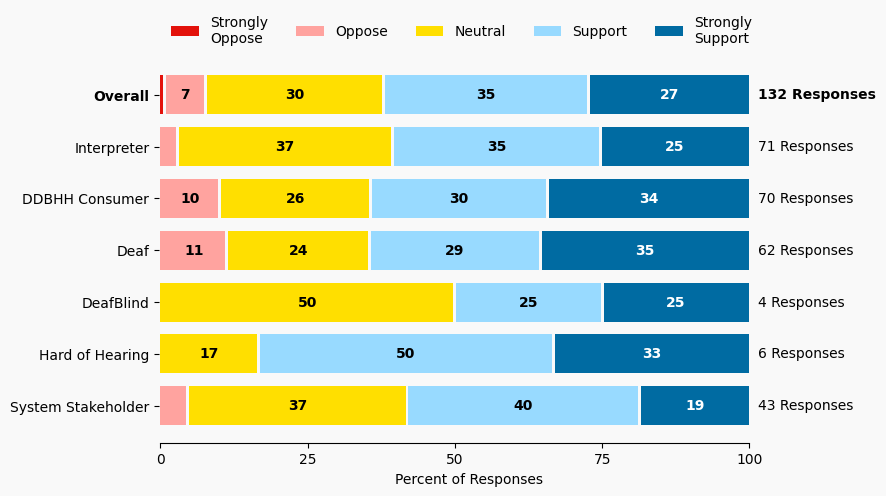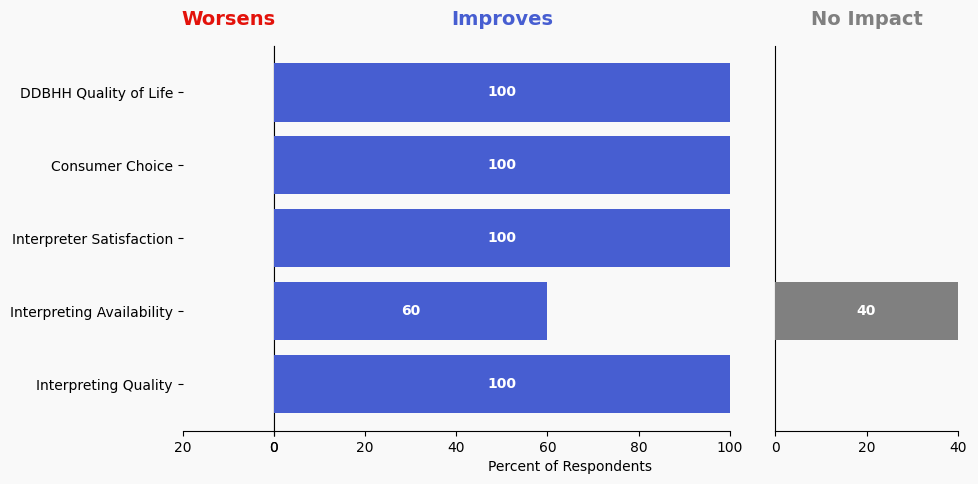6 Commission Host Self-Advocacy Training via Online Videos
Issue: More online training resources are needed for consumers.
Proposed Solution: Commission provide online video training or other easily accessible formats for DDBHH consumers to learn their rights, how to self-advocate, where to find resources to support their self-determination and how to effectively work with interpreters. Teach consumers how to get resolution to their customer service concerns and grievances. The Commission has a video series on accessible health care advocacy. This is a possible model to follow. Website URL: https://mn.gov/deaf-commission/advocacy-issues/healthcare/accessible-health-care/video-series/
Expected outcome: Consumers will better understand their rights and how to self-advocate when working with interpreters. Interpreters will experience greater clarity in their work expectations when working with empowered DDBHH consumers.
Who is impacted: Consumers
Timeline: 6 months

Summary of Support Image Description
The stacked bar charts show how respondents rated their level of support and the total number of responses. The percentage for the five support levels is shown from left to right: Strongly Oppose (Dark Red), Oppose (Light Red), Neutral (Yellow), Support (Light Blue), and Strongly Support (Dark Blue).
Respondents may identify with multiple subgroups. The overall level of support is:
Overall
Strongly Oppose: 1%
Oppose: 7%
Neutral: 30%
Support: 35%
Strongly Support: 27%
Click to see the detailed image description for each subgroup.
Interpreter
Strongly Oppose: 0%
Oppose: 3%
Neutral: 37%
Support: 35%
Strongly Support: 25%
Deaf
Strongly Oppose: 0%
Oppose: 11%
Neutral: 24%
Support: 28%
Strongly Support: 35%
DDBHH Consumer
Strongly Oppose: 0%
Oppose: 10%
Neutral: 26%
Support: 30%
Strongly Support: 34%
DeafBlind
Strongly Oppose: 0%
Oppose: 0%
Neutral: 50%
Support: 25%
Strongly Support: 25%
System Stakeholder
Strongly Oppose: 0%
Oppose: 5%
Neutral: 37%
Support: 40%
Strongly Support: 19%
Hard of Hearing
Strongly Oppose: 0%
Oppose: 0%
Neutral: 17%
Support: 50%
Strongly Support: 33%
Overview of Respondents Opting for In-Depth Solution Analysis
After indicating their support level, 3% of the 132 respondents opted in to further assess whether the solution would worsen or improve on five metrics. Of the opt-in reviewers (5 respondents), 40% supported the solution, 40% were neutral on the solution, and 20% opposed the solution.
The remaining 127 respondents did not opt in to further assess the solution. Of these people, 62% support the solution, 29% were neutral on the solution, and 7% opposed the solution.
Reviewer Evaluation of Solution Effectiveness

Solution Effectiveness Image Description
The stacked bar charts show how respondents assessed the effectiveness of this solution based on five metrics. For each metric, the percentage of respondents is shown from left to right: Worsens (Red), Improves (Blue), No Impact (Gray).
DDBHH Quality of Life
Makes It Worse 0%
Makes It Better 100%
No Impact 0%
Interpreter Satisfaction
Makes It Worse 0%
Makes It Better 100%
No Impact 0%
Consumer Choice
Makes It Worse 0%
Makes It Better 100%
No Impact 0%
Interpreting Availability
Makes It Worse 0%
Makes It Better 60%
No Impact 40%
Interpreting Quality
Makes It Worse 0%
Makes It Better 100%
No Impact 0%
Reviewer Feedback and Insights
Interpreter
No comments were submitted.
Deaf, DeafBlind, Hard of Hearing
Comments from DDBHH Consumers suggested finding ways to incentivize and empower individuals to create their own videos about self advocacy tools, such as developing a hashtag for Minnesota-specific advocacy, and amplifying Deaf content creators within Minnesota. One comment suggested that the NAD’s Deaf Self Advocacy Toolkit (DSAT) could be a resource for developing training.
System Stakeholder
Comments from System stakeholders indicated the need to ensure that the training content remains relevant and updated on an ongoing basis.
PREVIOUS SOLUTION
5 Educate All Entities on ADA Responsibilities and How to Access Interpreters
Issue: All organizations who need to hire interpreters often do not understand how to obtain quality and qualified interpreting services
NEXT SOLUTION
Issue: A platform is needed to provide feedback on interpreting services.
Leave a Reply